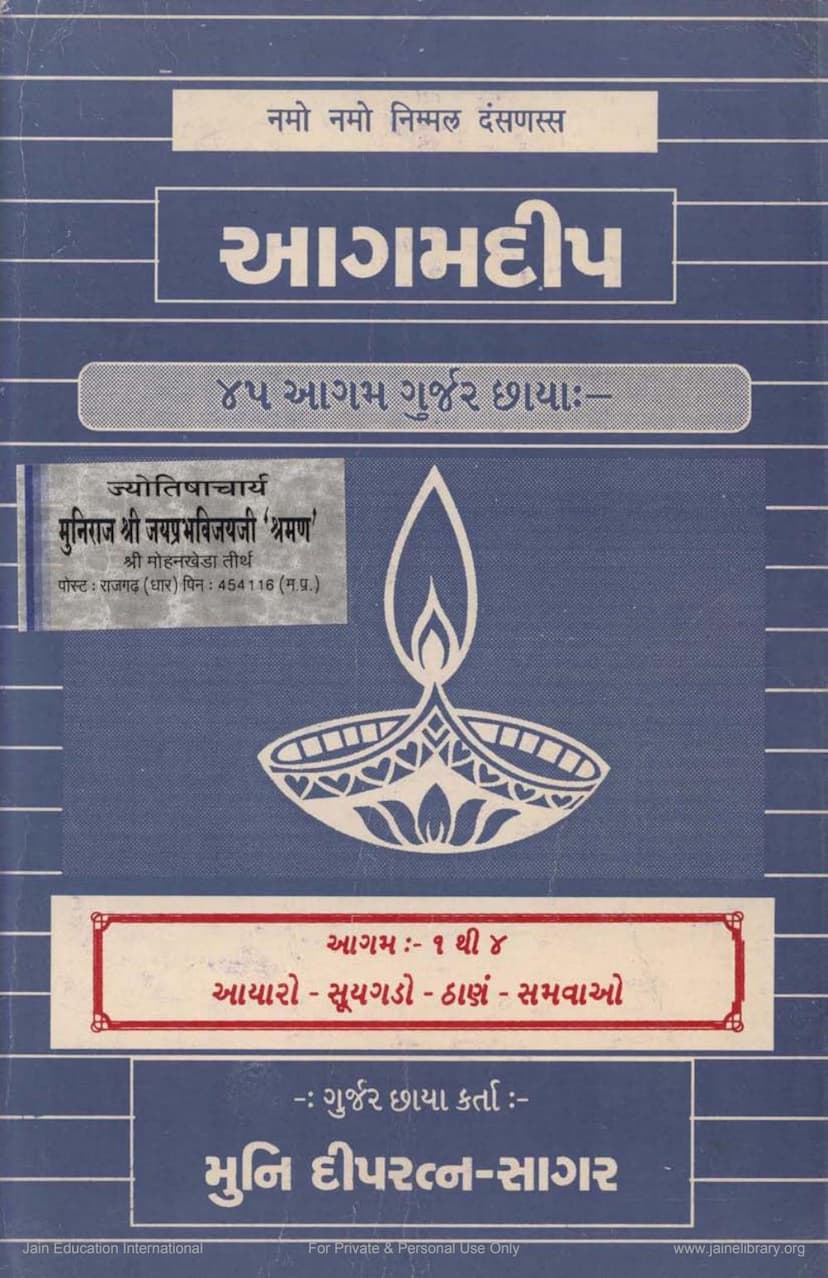Agam Deep 42 Dasaveyaliyam Gujarati Anuvaad
Added to library: September 1, 2025

Summary
This document is a Gujarati translation and commentary ("Gurjar Chhaya") of the Jain scripture "Dasaveyaliyam" (Dashavaikālika Sūtra), which is part of the Agam literature. The book is titled "Agam Deep 42 Dasaveyaliyam Gujarati Anuvaad," authored by Muni Deepratnasagar, and published by Agam Shrut Prakashan. The catalog link provided indicates this is part of a larger series titled "Agam Deep."
The provided text is a collection of pages from this book, detailing the Gujarati translation and commentary of several chapters (Adhyayans) of the Dasaveyaliyam Sutra.
Here's a breakdown of the content, based on the page descriptions:
Overall Purpose:
- Translation and Commentary: The primary goal is to make the Dasaveyaliyam Sutra accessible to Gujarati-speaking readers by providing a clear translation and insightful commentary (Gurjar Chhaya) on each verse and concept.
- Guidance for Monks/Nuns: The text extensively outlines the rules, conduct, and ethical principles that Jain monks and nuns (Shravaks and Shravikas in a broader sense) should follow in their spiritual practice and daily life.
- Spiritual Development: It emphasizes the path to liberation (Moksha) through adherence to the vows (Mahavratas), control of senses, renunciation, and detachment.
Key Themes and Content Covered (across various Adhyayans):
- The Nature of True Renunciation (Tyaga): Distinguishing genuine renunciation from mere external appearances.
- Control of Senses and Desires: Emphasizing the need to overcome passions like anger, pride, deceit, and greed.
- The Six Life Forms (Shat Jivanikay): Detailing the importance of protecting all living beings, from microscopic to macroscopic, and adhering to the principle of non-violence (Ahimsa) in all aspects of life. This includes detailed instructions on how to walk, sit, eat, and speak to avoid harming any life form.
- The Five Great Vows (Panch Mahavratas): Elaborating on the principles of non-violence, truthfulness, non-stealing, celibacy/chastity, and non-possession.
- Right Conduct (Achar): Providing detailed guidelines on ethical behavior, including:
- Bhiksha (Alms-gathering): Strict rules about when, where, and how to accept alms to maintain purity and non-violence. This includes avoiding specific households, certain times, and items prepared with impure intentions.
- Speech (Vach-shuddhi): Rules about speaking truthfully, kindly, appropriately, and avoiding harsh, divisive, or untruthful speech.
- Daily Conduct: Guidelines on personal hygiene, use of objects, interaction with others, and maintaining a disciplined lifestyle.
- Renunciation of Worldly Pleasures: Detailing the importance of avoiding attachment to possessions, comforts, and sensory pleasures.
- The Importance of Vinaya (Humility and Respect): Highlighting the paramount importance of respect towards one's Guru and elders, and the severe consequences of disrespect (Ashatna).
- The Path to Liberation (Moksha): Explaining how adhering to these principles leads to the shedding of karma and ultimately liberation from the cycle of birth and death.
- The Role of the Guru: Emphasizing the Guru's guidance in understanding scriptures and living a righteous life.
- The Significance of Tapa (Austerity): Explaining how austerity purifies the soul and helps in shedding karma.
Key Figures Mentioned:
- Lord Mahavir: The scripture is presented as the teachings of Lord Mahavir.
- Muni Deepratnasagar: The author and commentator.
- Various monks and nuns: Mentioned in relation to inspirations for financial support or as exemplars of conduct.
- Smt. Nayana Ben Rameshchandra Shah and family: A primary benefactor for the Agam Deep series.
Structure of the Document:
The document is presented as a series of pages, often referencing specific Adhyayans (chapters) and Udeshas (sections within chapters) of the Dasaveyaliyam Sutra. Each Adhyayan seems to focus on particular aspects of Jain practice and philosophy. The commentary ("Gurjar Chhaya") explains the verses in detail, often using analogies and examples to illustrate the spiritual points.
In essence, this publication aims to provide a comprehensive understanding of the Dasaveyaliyam Sutra for Gujarati readers, guiding them on the path of Jain spiritual discipline and ethical conduct.